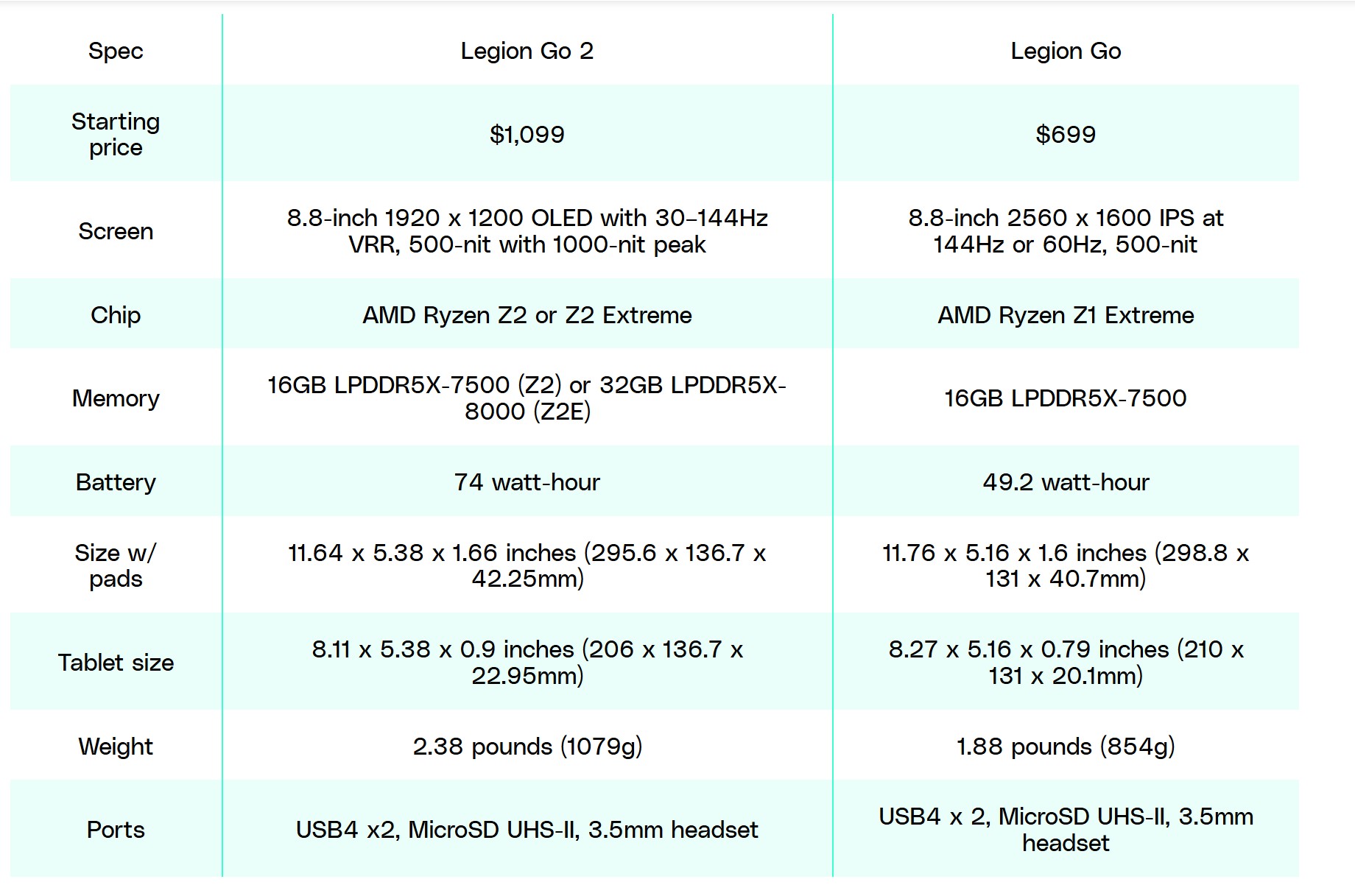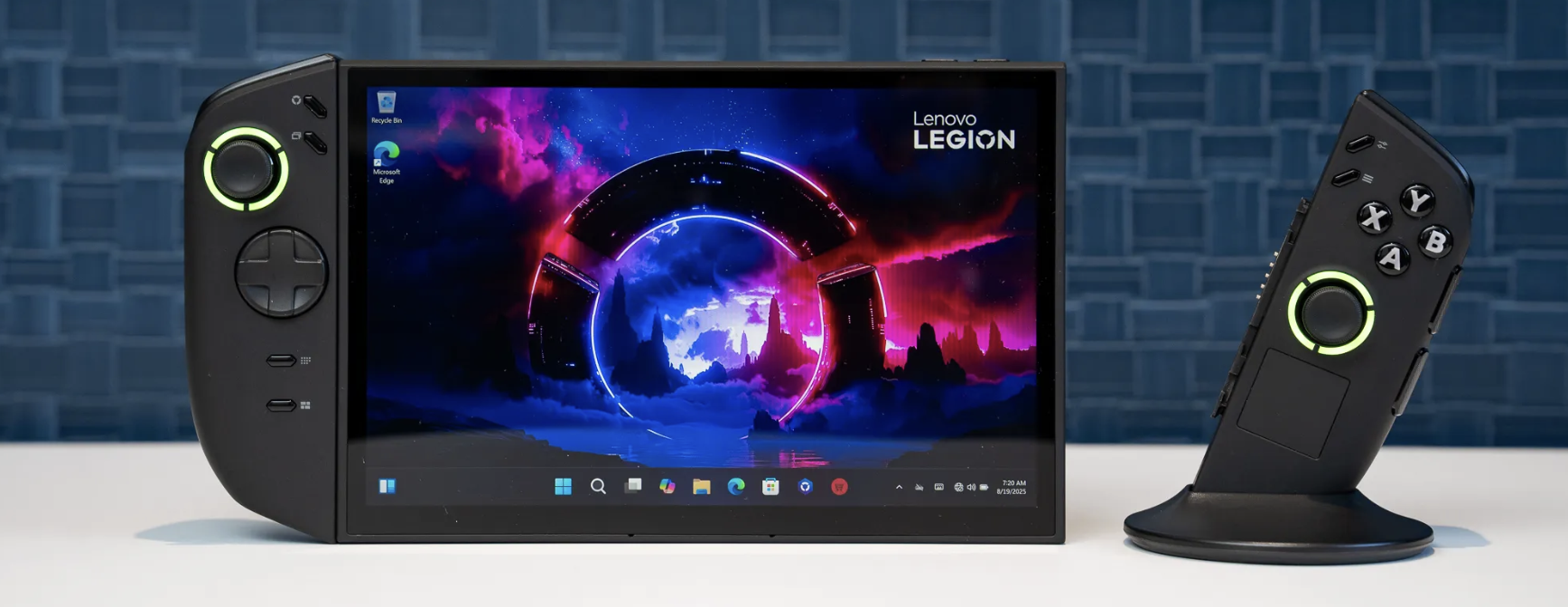Topher
Identifies as young
Bigger, heavier, almost certainly better.

Lenovo's Legion Go was a polarizing handheld gaming PC, and that won't change as the company officially announces its successor today: the new Legion Go 2 is slightly bigger, heavier, and costs at least $400 more than the original.
But in many other ways, it looks like Lenovo listened — and so this handheld, with its Switch-like detachable wireless controllers, built-in kickstand, and hidden optical mouse, might just be the ultimate portable PC when it arrives this October.
We already knew its newly sculpted controllers made it far more comfortable to hold and mouse around; now, it also has 50 percent more battery and possibly the best handheld screen money can buy.
Not only did Lenovo find an 8.8-inch OLED panel — with the inky blacks and gorgeous color OLED can afford — it's a true 30–144Hz variable refresh rate screen with a native landscape orientation, meaning even games that can only maintain 31 or 32fps on its handheld chip should still give you every extra frame of smoothness over 30. The original Legion Go didn't have VRR at all, and many VRR screens only go down to 48Hz, so 30Hz is a nice improvement.
And because Lenovo picked a lower-resolution panel at 1920 x 1200 instead of the overkill 2560 x 1600 of the original, it should be that much easier for its new Z2 or Z2 Extreme chip to deliver enough frames, too.
Speaking of those chips, the AMD Ryzen Z2 and Z2 Extreme probably aren't big upgrades over the last wave of handhelds. In fact, AMD admitted to me at CES that the Z2 is a match for the Z1E, but with software enhancements, and Lenovo's Jeff Witt confirms over email that Z2 and Z1E performance should be "much the same." The Z2E is a modest upgrade over the Z1E, according to ETA Prime's early tests with an MSI Claw A8. Every frame counts in a handheld where the latest games struggle to play smoothly, but I would hope for more.
Perhaps Lenovo got more out of it — I recall the original Legion Go being a tad faster than the original ROG Ally despite using the same Z1E chip. (This one can briefly hit 35W in its custom turbo mode.)
You can also now get 1TB of storage by default in North America, with 2TB in the highest-end config. All but the entry-level SKU have 32GB of RAM. There's also a fingerprint reader in the power button now, which is quickly becoming a standard feature on Windows handhelds.
And those sculpted controllers, which you'll also be able to buy and connect to the original Legion Go since they use the same mounting system, now have a proper pivot-point D-pad instead of the flat and shallow cross button of the original. They still feature drift-resistant Hall effect joysticks, too, and at CES I saw that the right pad's mouse skate accessory now locks into place so you don't fling it off when using the FPS mouse.
I'm afraid that handheld gaming PC prices are headed the wrong direction. The Legion Go 2 starts at $1,099.99 with an AMD Z2, 16GB of RAM, and 1TB of storage. You'll spend $1,199.99 for the model with 32GB of RAM, $1,349.99 for a Z2 Extreme with 32GB / 1TB, and $1,479.99 for the same with 2TB. I already thought the MSI Claw 8 AI Plus was pricey after MSI bumped it $999.99, and while this is pricier still, I wouldn't be surprised if that Claw's Intel Lunar Lake chip may be competitive with the Z2E in Lenovo's new handheld.
But price and performance aren't everything, and Lenovo already has the $830 Legion Go S with SteamOS for those who need to spend a little less for good performance. The Legion Go 2 may tempt those who'd pay extra for the best Windows handheld experience — though I suspect we may be redefining the Windows part of "best Windows handheld experience" after the Xbox Ally X arrives on October 16th.
Speaking of Windows and SteamOS, Lenovo isn't announcing a SteamOS version of the Legion Go 2 at this time, Witt tells The Verge. But it will get the same Xbox full-screen experience as Asus' Xbox Ally handheld in Spring 2026, he confirms. Buyers can choose to switch to that experience once it arrives.

 www.theverge.com
www.theverge.com
 kevboard
seems you may have been right about there not being a SteamOS version.
kevboard
seems you may have been right about there not being a SteamOS version.
Edit:
Legion Go 2, AMD Z2, 16GB of RAM, and 1TB: $1,099.99
Legion Go 2, AMD Z2, 32GB of RAM, and 1TB: $1,199.99
Legion Go 2, AMD Z2 Extreme, 32GB of RAM, and 1TB: $1,349.99
Legion Go 2, AMD Z2 Extreme, 32GB of RAM, and 2TB: $1,479.99

Lenovo's Legion Go was a polarizing handheld gaming PC, and that won't change as the company officially announces its successor today: the new Legion Go 2 is slightly bigger, heavier, and costs at least $400 more than the original.
But in many other ways, it looks like Lenovo listened — and so this handheld, with its Switch-like detachable wireless controllers, built-in kickstand, and hidden optical mouse, might just be the ultimate portable PC when it arrives this October.
We already knew its newly sculpted controllers made it far more comfortable to hold and mouse around; now, it also has 50 percent more battery and possibly the best handheld screen money can buy.
Not only did Lenovo find an 8.8-inch OLED panel — with the inky blacks and gorgeous color OLED can afford — it's a true 30–144Hz variable refresh rate screen with a native landscape orientation, meaning even games that can only maintain 31 or 32fps on its handheld chip should still give you every extra frame of smoothness over 30. The original Legion Go didn't have VRR at all, and many VRR screens only go down to 48Hz, so 30Hz is a nice improvement.
And because Lenovo picked a lower-resolution panel at 1920 x 1200 instead of the overkill 2560 x 1600 of the original, it should be that much easier for its new Z2 or Z2 Extreme chip to deliver enough frames, too.
Speaking of those chips, the AMD Ryzen Z2 and Z2 Extreme probably aren't big upgrades over the last wave of handhelds. In fact, AMD admitted to me at CES that the Z2 is a match for the Z1E, but with software enhancements, and Lenovo's Jeff Witt confirms over email that Z2 and Z1E performance should be "much the same." The Z2E is a modest upgrade over the Z1E, according to ETA Prime's early tests with an MSI Claw A8. Every frame counts in a handheld where the latest games struggle to play smoothly, but I would hope for more.
Perhaps Lenovo got more out of it — I recall the original Legion Go being a tad faster than the original ROG Ally despite using the same Z1E chip. (This one can briefly hit 35W in its custom turbo mode.)
You can also now get 1TB of storage by default in North America, with 2TB in the highest-end config. All but the entry-level SKU have 32GB of RAM. There's also a fingerprint reader in the power button now, which is quickly becoming a standard feature on Windows handhelds.
And those sculpted controllers, which you'll also be able to buy and connect to the original Legion Go since they use the same mounting system, now have a proper pivot-point D-pad instead of the flat and shallow cross button of the original. They still feature drift-resistant Hall effect joysticks, too, and at CES I saw that the right pad's mouse skate accessory now locks into place so you don't fling it off when using the FPS mouse.
I'm afraid that handheld gaming PC prices are headed the wrong direction. The Legion Go 2 starts at $1,099.99 with an AMD Z2, 16GB of RAM, and 1TB of storage. You'll spend $1,199.99 for the model with 32GB of RAM, $1,349.99 for a Z2 Extreme with 32GB / 1TB, and $1,479.99 for the same with 2TB. I already thought the MSI Claw 8 AI Plus was pricey after MSI bumped it $999.99, and while this is pricier still, I wouldn't be surprised if that Claw's Intel Lunar Lake chip may be competitive with the Z2E in Lenovo's new handheld.
But price and performance aren't everything, and Lenovo already has the $830 Legion Go S with SteamOS for those who need to spend a little less for good performance. The Legion Go 2 may tempt those who'd pay extra for the best Windows handheld experience — though I suspect we may be redefining the Windows part of "best Windows handheld experience" after the Xbox Ally X arrives on October 16th.
Speaking of Windows and SteamOS, Lenovo isn't announcing a SteamOS version of the Legion Go 2 at this time, Witt tells The Verge. But it will get the same Xbox full-screen experience as Asus' Xbox Ally handheld in Spring 2026, he confirms. Buyers can choose to switch to that experience once it arrives.

Legion Go 2 official: Lenovo’s new flagship handheld costs $1,099 — and up
Do we get what we pay for?
Edit:
Legion Go 2, AMD Z2, 16GB of RAM, and 1TB: $1,099.99
Legion Go 2, AMD Z2, 32GB of RAM, and 1TB: $1,199.99
Legion Go 2, AMD Z2 Extreme, 32GB of RAM, and 1TB: $1,349.99
Legion Go 2, AMD Z2 Extreme, 32GB of RAM, and 2TB: $1,479.99
Last edited:




